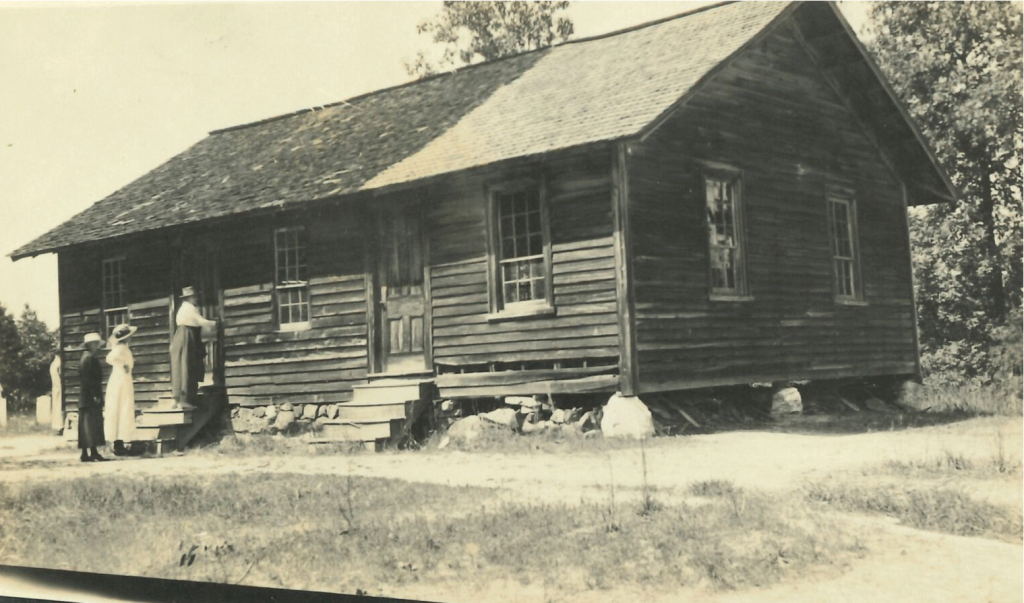
Pine Woods Preparative Meeting Established in 1791, soon after and under the watchful eye of Springfield, Pine Woods sat two miles north of the present city of Thomasville. The building was also used as a schoolhouse. In the early 20th century the property was sold to the Methodist Episcopal Church, and Pine Woods United Methodist Church now stands near the site. The ancient Quaker burial ground stands on the next hill behind as a tribute to Pine Woods Meeting.
Kennett Preparative Friends Meeting – Kennett Preparative Meeting was established in 1800 at the corner of what are now Kivett Drive and Kersey Valley Road.. The meetinghouse was a log structure about 16 by 18 feet with a large rock chimney. It, too, was used for both meeting and school purposes until 1867 when the Meeting was abandoned. Springfield deeded the land to Guilford County
Providence – In the early 1870snear the intersection of today’s Fairfield and Liberty Roads, was “… a place where liquor was freely dispensed and wickedness prevailed.” Although not members of Springfield Friends Meeting, Nancy Holton and members of her family attended on a somewhat regular basis. She was one of a dedicated and determined band of women who, in the winter of 1873, attacked the saloon keepers with prayer and persuasion, working to close out the business. Temperance meetings and “tract readings” were held at this place, and Nancy called the place “Providence.”
Bundy’s Chapel – A group of Wesleyan Methodists began to meet in the mid-19th century, organizing about 1860 and building a church on land owned by Nathan Bundy, a member of Springfield Friends. The name was changed to “Hickory Chapel Wesleyan Church” in December 1891, and the church relocated to its present site near the intersection of Hickory Chapel Road and Martin Luther King Jr. Drive (formerly Kivett Drive).
Oak Forest – White’s School House had operated for some time south of present-day Archdale before it was moved to a site on today’s Deaton Road and renamed “Oak Forest School.” A Quaker congregation began meeting in the area. The property was sold in 1889 and turned over to the Randolph Country Board of Education.
Archdale – During the nineteenth century Bush Hill had grown as a commercial center. In the mid-1880s the local Quakers began holding separate meetings for worship in the loft of Winston Frazier’s harness shop to avoid the trek across the hill to Springfield. Soon the congregation outgrew the harness shop and moved its services to the Bush Hill School. As the congregation strengthened, the Archdale group decided they wanted to become an independent Quaker meeting. Springfield, the home meeting, supported and sponsored them; and Archdale officially became a monthly meeting in 1924.
High Point – In 1883, the North Carolina Yearly Meeting moved from New Garden to High Point and erected a building on Elm Street. Today’s Church Street leads from Main Street to the Elm Street site. As High Point continued to grow, the need was seen for a Friends meeting in its midst. High Point Monthly Meeting was set off from Springfield as a monthly meeting on 7th, 1st month, 1892. A stone meetinghouse, built on the corner of Main Street and Commerce Avenue, became the home of High Point Friends in 1903. They moved to their present meetinghouse, on Quaker Lane, in 1956.
Oak Hill – Oak Hill Friends Meeting can be considered a “grandchild” of Springfield. In 1861, Jacob and Addison Hedgecock established a one-room schoolhouse at what is now the corner of Burton and English in western High Point; the following year Springfield Meeting started a Sunday School here.. In 1879 the Oak Hill Preparative Meeting was established under the watchful eye of Springfield. In 1908, Deep River Quarterly Meeting established a monthly meeting at Oak Hill, under the sponsorship of High Point Friends Meeting. A new meetinghouse was built in 1956 at the corner of Ward Street and Westchester Drive.
Adapted from an article written by Dan Warren